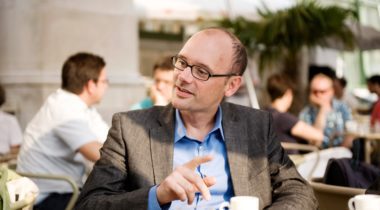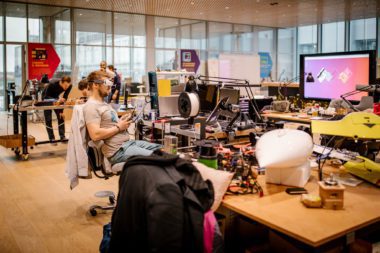“Single, double, triple loop learning”
We are living in a knowledge-driven society. Generating and using new knowledge successfully is a decisive competitive factor in our work-life — for individuals as well as for companies. In order to keep their competitive advantage, organizations should thus focus on designing learning settings, which go beyond mere knowledge transfer; such setting should enable people to identify and jointly explore new, unknown, “emerging” knowledge.
Despite positive efforts to improve teaching/learning content, methods and spaces, there is still a tendency to “objectify” learners, seeing them as empty vessels, which have to be filled with new knowledge, skills and methods.
However, in order to engage people in learning — in the sense of a radical renewal of already existing knowledge — it is necessary to focus on the individual person, in his/her distinctness, and to ask the following questions: “What is the human being? What does it mean to have a holistic view of the human being as a learner? How does this person need to change him/herself, so that what he/she has learned not only remains abstract, but can be brought into life?”
The “Human Being in the centre” – Implications for learning and knowledge processes
In the human being, three levels closely interact with one another:
- Vegetative level: this level includes aspects such as food intake, (physical) growth, reproduction and action.
- Sensitive level: this level concerns perception (“How do I perceive the world through my senses?”) and emotions (“How do I experience the world?”).
- Existential / spiritual level: this level is about a deep understanding of the world, what the world really is and means for the individual; it is about attitudes and values and about being capable of changing them through conscious decisions (free will). Every process of deep understanding and conscious decision-making leads to (spiritual) growth.
The vegetative, sensitive and spiritual levels are closely connected. For example, I can only want something (in the sense of being able to decide freely and willingly that I really want this “something”) after I have perceived it and after I have understood how I feel about it.
Consciously designed teaching/learning settings take into account all three of the above described. Only then can learning do justice to the wholeness of the individual and increase learning success.
Developing such an integrative concept is a challenge. Let us give you some starter: Ideally, (abstract) content also has an emotional component. Better yet, abstract content is combined with a visual trigger. At best, learning contents go hand in hand with a concrete action or exercise – they are then much easier to understand and translate into daily action.
In fact, most learning settings still only address one of the three levels — therefore the learning success often remains far below expectations.
Teaching/learning strategies that enable holistic learning
Linear learning
Still a classic and widespread: a teacher reads the material and the learner listens (and takes notes). In such a linear way, however, the appropriation of the learning material also occurs, for example, through the consumption of texts, books, websites, television, etc. Pre-existing knowledge is “downloaded” like an object, memorized and reproduced by the learner.
Assumptions behind this learning strategy
- Knowledge is a static object. Its meaning is not or hardly negotiable: Learning is a matter of reproducing what has been heard or read as exactly as possible (while not necessarily understanding it).
- Learning takes place in the (individual) mind: Knowledge is transferred from one brain to another. Learning does not happen in interaction, but by passively absorbing the learning material.
- In a linear learning setting, there is virtually no reflection on the subject matter. This leads to learning without understanding: Content can be recorded and reproduced, even if it wasn’t understood.
Examples of linear learning methods: Lecture, frontal teaching, learning from textbooks, films and web documents.
What is taught: Factual knowledge.
Single Loop Learning
Single Loop Learning focuses on the “how” or the function of a phenomenon. Single loop learning is a relatively conservative learning strategy: there is no place for questioning or changing of what already works well.
Assumptions behind this learning strategy
- Knowledge is a dynamic process, which arises from (direct) interaction and experience with the environment. Knowledge structures adapt to environmental structures.
- Learning is a trial-and-error process: prediction errors (see Predictive Mind theory) trigger a learning process and lead to a change in knowledge. An open attitude towards “mistakes” is a requirement for this.
The resulting knowledge tries to answer the question: “How does something work?” Such knowledge is seen as a construct, which changes constantly, with every interaction. In single loop learning, there is no reflection on assumptions (in the sense of “Why does something work the way it works?” or “Could it work differently?”).
Exemplary methods: learning on an object, learning from direct (subjective) experiences, role-playing, prototyping.
What is taught: Experiential knowledge; skills.
Double Loop Learning
Double Loop Learning assumes that knowledge is embedded in a frame of reference, of subjective assumptions and personal views on everyday phenomena. We form assumptions based on our interactions with the environment, through cultural learning processes, education, etc. Assumptions determine the scope of how we interpret knowledge and how we create meaning — in most cases , assumptions are not explicit. However, we can change our assumptions if we are capable of opening ourselves to reflection and questioning.
Double Loop Learning aims not only to make assumptions explicit, but also to change them systematically. This creates a new space of meaning in which already known phenomena can be seen from a new perspective. A well-known example for this is the paradigm shift from the geocentric to the heliocentric worldview. This new perspective on the world made modern navigation possible in the first place.
In a Double Loop Learning setting, we reflect upon, we question and change our assumptions — thereby creating new knowledge spaces and ultimately new spaces for action and interaction.
Exemplary methods: Dialogue, reflection, structural mapping technique, the teacher sees himself as a coach.
What is taught: Understanding and insight into one’s own assumptions of thinking; ability to change these assumptions.
Triple Loop Learning
While Single and Double Loop Learning primarily aim at changes on the cognitive and affective level, Triple Loop Learning, according to Markus Peschl, focuses on the existential / spiritual level of the individual person — i.e. his/her individual values and attitudes. Triple Loop Learning is thus not primarily about teaching new skills or knowledge, but about enabling personal change and transformation. Triple Loop Learning is about values, attitudes and “habitus”. Triple Loop Learning takes longer than the other two types of learning, since it is about deep changes of the human being, about the maturing of a person, about “finding oneself”.
Therefore, Triple Loop Learning is also the most difficult form of learning, because it is very personal and “about oneself”. It requires a strong will for personal change and goes far beyond knowledge and skills.
Exemplary methods: different forms of therapy, formation, Theory U (according to Otto Scharmer), leap and frame (theLivingCore), asking existential questions, profound experiences (“life changing events”).
What is taught: Understanding and insights into one’s own values and attitudes; insight into one’s own purpose (“What does life want from me?”); clarity about differences or similarities between one’s personal values and attitudes or the values of the company; ability to relate (daily) actions to one’s own (desired) values and attitudes or to link them with each other.
In general, organizations have a massive amount of knowledge at their disposal — which goes hand in hand with the power and the responsibility to shape the (economic, ecological, social, political) future. Designing holistic learning settings, which are not only aimed at transferring knowledge or building skills, but also focus on the whole person with his or her individual life questions and potentials, is not only an economically relevant task, but also a service to society.
Our experience in various project shows that the concept of Triple Loop Learning provides a forward-looking guidance to tackle those challenges – both on an individual and on an organizational level.
Subscribe to
our newsletter
Get special insights on radical innovation and building desirable futures every second month.
Further readings:
Argyris, C and D.A. Schön (1978). Organizational learning: a theory of action perspective. Reading, MA: Addison-Wesley.
Argyris, C. and D.A. Schön (1996). Organizational learning II. Theory, method, and practice. Redwood City, CA: Addison-Wesley.
Peschl, M.F. (2007). Triple-loop learning as foundation for profound change, individual cultivation, and radical innovation. Construction processes beyond scientific and rational knowledge. Constructivist Foundations 2(2-3), 136–145.
Tsoukas, H. and N. Mylonopoulos (Eds.) (2004). Organizations as knowledge systems. Knowledge, learning and dynamic capabilities. Basingstoke, New York: Palgrave Macmillan.
Image: Timo Volz at Unspash


